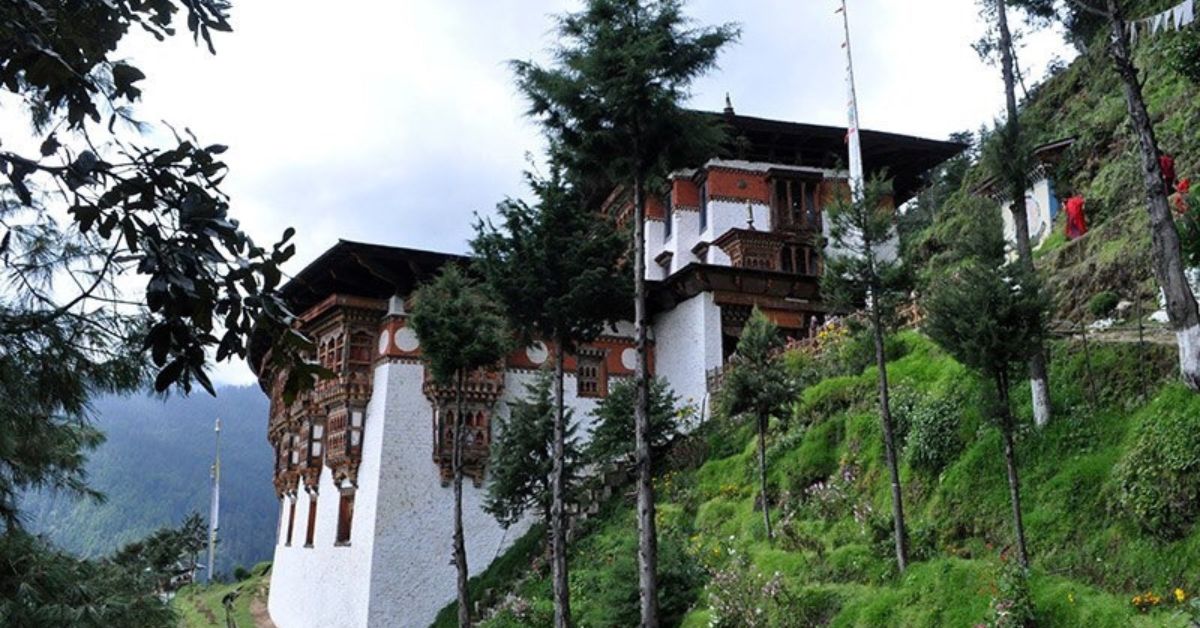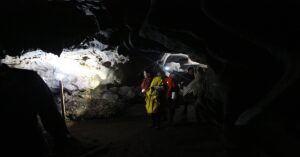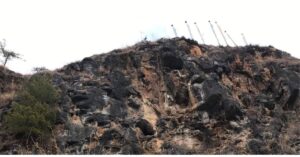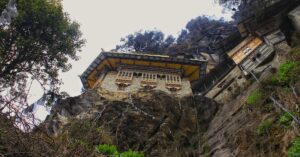Tango Choying Dzong is the most important site of Phajo Drugom Zhigpo, where Yidam Tandin appeared before him in person and delivered precepts to him. Therefore, the sacred site was named Tango, meaning “horse head”. It is a Buddhist Monastery in Thimphu Dzongkhag at an altitude of 2946 meters, adjacent to Cheri Monastery.
Phajo Drugom Zhigpo founded Tango Choeying Dzong, a meditation hermitage near Cheri Mountain in the 13th century. However, some argue that Lama Gyalwa Lhanampa founded the Tango before the arrival of Phajo.
The current structure of Tango Monastery, with a 3-storey central tower and 12 corners, was built by Tenzin Rabgye in 1688.
Tango Monastery holds the annual festival “Yarnay” from the 15th day of the 6th month to the 30th day of the 7th month of the Bhutanese calendar.
How to Reach Tango Monastery
The monastery is accessible by the road to the base. It is 14 kilometers (9 miles) from Thimphu City and takes at least a 30-minute drive to the end of the Dechenchholing-Dodena road along the Thimphu Chhu. From the base, you must hike for about an hour to reach the Tango Monastery.
Tango Monastery Hike
Tango Choying Dzong is a historic site for taking an easy pilgrimage hiking experience in Thimphu. The day hike to Tango Monastery starts with a drive to the Northern end of Thimphu through the beautiful countryside of Begana village. The hike to Tango Monastery begins from the car parking and will take you nearly 1 hour and 30 minutes uphill through a well-paved and comfortable path. The distance from the base to the Tango monastery is 2 kilometers.
Walking along the stone-paved path into the deep wilderness of rhododendron and oak vegetation, you will hear birds chirping. You can experience some of the most beautiful scenery and exotic floral and faunal biodiversity. You may find many profound and enjoyable phrases written by the monks along the way.
Also Read: Domendrel Tsho Hike
Hiking for about 40 minutes, you will come to a chorten. You will have an excellent view of a monastery and several meditation houses from here. From there, hike up another 20 minutes to the monastery.
After visiting the Tango Monastery, you must follow the same hike route downhill, which will take nearly 40 minutes. The round-trip hike is about 2.5 km, and the estimated hiking time is about 2 hours.
If you wish, you can complete the Tango and Chagri monastery hikes in a single go.
Sacred Relics to See at Tango Monastery
- The image of Tandin (Hyagriva);
- A golden key discovered by Ngawang Tenzin, in the shape of a horse head;
- A stone with a clear footprint of Jetsuen Tenzinma, daughter of Ngawang Tenzin;
- A stone impression of riding horses, goats, and sheep;
- The six chapels of Tango Monastery;
- Meditation cave near Tango Monastery.
Also Read: Guru Rinpoche in Bhutan: His Visits to Bhutan and Sacred Sites
Historical Significance of Tango Choying Dzong
The earliest history traced to this location is when Guru Rimpoche identified the place as representing the Hayagriva or horse head in the 8th century.
The Prophecy to Phajo Drugom Zhigpo
According to the biography of Phajo Drugom Zhigpo, Tango Choyeing Dzong is one of the four Dzongs out of the twelve meditation places, which consist of four Dzongs, four Cliffs, and four Caves entrusted to him by Guru Rinpoche. The other three are Lingzhi Jago Dzong, Taktsang Senge Samdrup Dzong, and Yangtse Thuwo Dzong.
As per the prophecy, Phajo Drugom Zhigpo went on a visit to Cheri Mountain. There, he heard the neighing of a horse coming from the direction of where the Tango Choying Dzong monastery is located today. Phajo witnessed the cliff, hills, and rocks in the form of the mandala of Yidam Tandin (Bhagavat Hayagriva, the horse-headed deity, the crown of its head blackish-green) engulfed in flames. The Avalokiteshvara revealed himself as “the self-emanated form of the Wrathful Hayagriva” to Phajo. He then went up and prostrated himself before Hayagriva.
Hayagriva said, “You, my son, whose coming was predicted by the Guru, you should not be small-minded, but you should possess the Bodhicitta (Bodhisattva mentality). Constantly keep in mind the predictions of the Guru.“
According to the prophecy, Phajo Drugom Zhigpo established a meditation hermitage, Tango Choying Dzong, in 1222. Phajo meditated for a long period and attained the vision of all the tutelary deities.
Later, Dampa, the first son of Phajo, built a monastery with five doors. He also built 21 hermitages and established a Drupdey behind the hill of Chubar. Subsequently, he appointed his son Kuenzang Dorji as his successor to Tango Choeing Dzong.
During the 8th Rabjung, Choeje Drukpa Kunley came and blessed the place. He prayed that his successors would take care of Tango Monastery.
Opening of Tango Choying Dzong
The divine son of Drukpa Kunley, Ngawang Tenzin, then aged 50, opened the door of Tango following the prophecies of Dakinis and Dharmapalas. By the late sixteenth century, Mipam Tsewang Tenzin of Dorden (now Dodena), son of Ngawang Tenzin and also considered a reincarnation of Phajo Drugom Zhigpo, took control of the site.
The Visit of Zhabdrung Ngawang Namgyal to Tango Choying Dzong
When Zhabdrung Ngawang Namgyel arrived in Tango, Mipham Tshewang Tenzin offered him Tango Choying Dzong. Zhabdrung then accepted the Dzong and meditated in the cave of Tango to perform the tantric ritual of Gempo. After gaining spiritual powers from meditation, he killed his enemy, Desi Tsangpa, and his queen. As a celebration of his victory by making offerings to the Dharmapalas, he composed “Nga Chudugma or My Sixteen Accomplishments”.
He then returned to meditate. At midnight, the demons of the valley caused the horse-head cave to tremble with loud swishing and thundering sounds. A large lump of rock, equivalent in size to a yak’s body, came crashing down towards Zhabdrung’s head.
Following this incident, the villagers started spreading the rumor that the Zhabdrung was dead, but those who had faith in him went to Tango and saw that he was not harmed and was sitting more radiant than ever. This event increased the people’s faith in him. They returned to their village and they put a white flag for the gods on the top of their roofs. From this day, it is said that the tradition of putting flags on the roofs was established.
Zhabdrung Rinpoche named this cave Duedulphug, a cave where demons were subdued.
The Foundation of Tango Choying Dzong
Phajo Drugom Zhigpo established a meditation hermitage known as Tango Choying Dzong in the 13th century.
Development of Tango Monastery, Bhutan
The 4th Desi Tenzin Rabgye assigned his secretary, Drung Norbu, to supervise the construction of this architectural grandeur. Tenzin Rabgye built Tango Monastery within 2 months of its construction in 1688 A.D. The central tower has twelve corners, making the architectural facade unique and magnificent.
Also Read: The Construction of Paro Taktsang Singye Samdrup Dzong
Lam Pekar Lhendup, the third Je Khenpo, presided over the consecration ceremony. At the beginning of the 18th century, the 8th Druk Desi Druk Rabgye added some structures to the Tango Choying Dzong monastery to bring it to its present stature. In the late 19th century, Zhabdrung Jigme Choegyal installed a golden rooftop on the monastery.
In 1966 AD, the 64th Je Khenpo Jamyang Yeshey Sengyel and Her Royal Highness the Grandmother Ashi Phuntshog Chodon restarted the School of Buddhist Studies. Her Majesty the Queen Mother Ashi Kesang Wangchuck refurbished the monastery into an elegant structure vis-à-vis the original in 1977 AD.
Description of the present Tango Monastery Complexes
Built like a traditional dzong, the Tango Choying Dzong Monastery houses caves and temples. One of the most significant features of its architecture is its semicircular outer wall. It is a three-story building with six major temples on different floors in the monastery.
A natural fountain is in the middle of the courtyard opposite the central tower. Between the Dzong and the monastery is a Jangchub Chorten or Kudung Chorten, built with the ashes of Gyalse Tenzin Rabgye.
The large sandalwood tree is a walking stick of Phajo. Phajo Drugom Zhigpo planted it, saying, ‘This will be the center from which the Drukpa Kargyud doctrine will spread’. There is a Chorten near the cypress trees where Khandro Sonam Peldon died.
Caves
The caves are where the holy saints meditated from the 12th century onwards. The rock face identified as the ‘Horsehead’ or ‘Hayagriva’ is integral to the rock setting of the caves.
Inside the rock is a cave. The upper and lower parts of the cave are divided into four levels. At the center is a secret self-emanated cavern of a dakini. The self-emanated figures of the sun and the moon are at the side of the rock. A self-emanated impression of the demon Matramrutra can be found at the bottom of the cave.
In the basement of the cave, there is a long passage of rock, which differentiates the virtuous from the non-virtuous deeds.
Also Read: The Sacred Cave of Guru Rinpoche in Kurjey Lhakhang of Bumthang
The Architecture of Tango Monastery
The Tango Choying Dzong Monastery is built in the Dzong structure. It covers the caves where saints performed miracles and other religious activities, such as meditation, from the 12th century onwards. Tango Monastery has a prominent main tower with recesses. You will find engraved slates behind the prayer wheels inside the monastery. It has semi-circular walls from the outside. Just outside the Tango monastery is a courtyard with a gallery illustrating the leaders of the Drukpa Kagyupa lineage.
Tango Monastery Thimphu
The 12-cornered Tango Monastery complex has six temples in total, including Trulku Lhakhang, Longku Lhakhang, Choeku Lhakhang, Guru Lhakhang, Namsey Lhakhang, and Gonkhang.
Trulku Lhakhang
The ground floor of the Tulku Lhakhang, where the main deity, Buddha, is installed, is made of gold and copper. The Buddha statue is nearly 15 feet tall. Panchen Deva of Nepal was the sculptor of this statue. Flanking the main deity are a clay Buddha Dipankara cast in medicinal metals and a statue of Maitreya nearly 10 feet tall, double the height of a man. The life-size statues of the 8 chief spiritual sons of the Buddha (the Jang Sem Nye Wai Say Chen Gyad, which are Jamyang, Chador, Chenrizig, Namkhai Nyingpo, Dripa Namsel, Saye Nyingpo, Jamba, and Jampel Zhenu Jurpa) are also housed here. Trulku Dzing and Druk Chophel are credited for sculpting these statues.
In the Jokhang is a stone with a distinct footprint of Jetsuen Tenzinma, daughter of Ngawang Tenzin. Together with this, there are various other impressions of riding horses, goats, and sheep. One of the main relics of the monastery is a golden key in the shape of a horse head, which Ngawang Tenzin discovered from the Thuji Drak at Phajoding.
Another adjoining temple, the Gonkhang or the Mahakala temple, is dedicated to the four-handed Mahakala (Pel Yeshey Gonpo, the protective deity) holding the skull of a human in one hand. The skull is believed to be of the Tibetan King, Thrisong Detsan.
Longku Lhakhang
On the second floor is the Longku Lhakhang (temple of Sambhogakaya). You can see the statue of Avalokiteshvara– the Buddha of compassion, which Panchen Deva of Nepal made with gold and copper, installed.
The other Lhakhangs on the second floor are Guru Lhakhang and the Namsey Lhakhang, where the statue of Namsey (Vaisravana – the god of wealth) is revered.
Choeku Lhakhang
The third floor is the Choeku Lhakhang (temples of Dharmakaya). You can see the gold and copper statue of Buddha Amitayus made by Panchen Deva. A statue of Zhabdrung Ngawang Namgyal and Gyalse Tenzin Rabgye flanks Buddha Amitayus. Gyalse Tenzin Rabgye’s bedroom is on the right side of the Tango Monastery.
The Wall Paintings of Tango Choying Dzong Monastery
The wall paintings are seen on all three floors of the monastery. The wall paintings of Tango Choying Dzong are unique, and only a handful of such paintings exist in the world. Tango Choying Dzong’s paintings hold tremendous importance due to their religious significance, subject matter, art technique, and the era in which they were created. Unlike modern Bhutanese paintings, these are not produced in workshops or painted on industrial-produced cloth. Instead, they are painted directly on the adobe walls. The paints are all from natural products; a style unique to the 17th century, making it precious.
The most unique painting is the Weeping Guru. When Desi Tenzin Rabgey died, the painted image wept, leaving red spots in the corners of its eyes, making it the only painting of such art. The priceless paintings of Tango Choying Dzong are on the walls of the northern shrine rooms on the second and third floors of the Utse. Tsang Khenchen painted the murals in Tango Choying Dzong.
Festival at Tango Monastery
The monastery holds the Yarney festival (‘Yar’ means “Summer” and ‘Ney’ means “To stay”), an important annual event lasting one and a half months. During this period, the monks and nuns enter a summer retreat from the 15th day of the 6th month to the 30th day of the 7th month of the Bhutanese calendar. Tango Monastery initiated the annual festival of Yarney in 1967. The common people make food offerings to the monks during this retreat period.
The monks observe special vows and the strictest monastic disciplines during the retreat. They wear ceremonial yellow robes and chant prayers by remaining within the boundary marked by pebbles around the monastery.
This practice originated when the Buddha walked the earth, and all monks depended on alms for a living. Non-believers criticized the monks, saying that they were killing so many insects by trampling them, since even during the months of summer, the monks went around begging for alms. The Buddha, therefore, decreed that from that moment on, all the monks and nuns were to remain indoors during the peak summer months.
Also Read: The Festival of Gomphu Kora
The Importance of Tango Choying Dzong Monastery
Tango Monastery is an important Buddhist monastery in Bhutan with significant historical, religious, and cultural significance. Firstly, the importance of Tango Monastery dates back to the time of Guru Rinpoche. He identified the place as representing the Hayagriva or horse head. Secondly, Guru Rinpoche entrusted the place to Phajo Drugom Zhigpo, and he founded Tango Choying Dzong where Avalokiteshvara revealed himself as “the self-emanated form of the Wrathful Hayagriva” to Phajo in the 13th century. Thirdly, Zhabdrung Ngawang Namgyal meditated in the caves of Tango Monastery and composed the “Nga Chudugma or My Sixteen Accomplishments” in the 17th century.
Best Time to Visit Tango Choying Dzong Monastery
The best time to visit Tango Monastery is spring and autumn, from March to May and September to November. The mild weather, fewer crowds, and coinciding religious festivals make spring and autumn the ideal time to visit Tango Monastery and fully experience its spiritual and natural beauty. The scenic hike to the monastery is also most enjoyable during these seasons. You can visit major pilgrimage sites in Thimphu with the Bhutan Pilgrimage Package.
What to Bring on a Tango Monastery Hike
To ensure a comfortable and enjoyable hike to the Tango Monastery in Bhutan, consider bringing the following items:
- Comfortable Hiking Shoes: The hike is approximately 2 kilometers uphill and takes about 1 hour and 30 minutes. Wear sturdy and comfortable shoes best for hiking or trekking.
- Clothing: Dress in layers for the changing weather conditions. Carry a hat, sunglasses, and sunscreen.
- Water and Snacks: Carry water and snacks to keep you hydrated and energized throughout the hike.
- Camera: Carry a camera to capture these moments.
Other Sacred Sites to Explore in Thimphu
Dechenphu Lhakhang: It is a monastery dedicated to Geynyen Jagpa Melen, a powerful protective deity, located at the northern end of the Thimphu Valley in Bhutan. The Temple was constructed in the 12th century by Dampa, the son of Phajo Drugom Zhigpo.
Pangri Zampa Monastery: It is one of Bhutan’s oldest monasteries, founded in the 16th century by Ngawang Chogyal, located 8 kilometers north of Thimphu on the west bank of the Thimphu River. The monastery now functions as Bhutan’s Royal College of Astrology, where monks study traditional astrology, and the college is responsible for determining dates for important national events.
Cheri Monastery: Also known as Chagri Dorjeden Monastery, it is the first monastery established in Bhutan by Zhabdrung Ngawang Namgyel in 1620. It is located in the Upper Thimphu Valley, about 15 kilometers north of Thimphu city, perched on a hill at an altitude of approximately 2,850 meters above sea level.
Tashichho Dzong: Built in 1216 and rebuilt in 1962, it is a fortress-monastery that houses the king’s throne room, government offices, and the central monastic body. Known as the “Fortress of the Glorious Religion,” it blends religious and administrative functions with stunning Bhutanese architecture.
Thuji Dra Monastery: Also known as the Cliff of Compassion, it is one of the four cliffs prophesied by Guru Rinpoche to Phajo Drugom Zhigpo. The Thujidra Temple is located at an altitude of nearly 4,000 meters, where Phajo saw in a vision Phagpa Thujechenpo while meditating here.
Frequently Asked Questions
Why is the Tango Monastery important?
Tango Monastery in Bhutan is a revered pilgrimage destination, founded in the 13th century by Phajo Drugom Zhigpo. It is a significant spiritual center, serving as the seat of the Druk Desi and a Buddhist university. Guru Padmasambhava blessed the monastery in the 8th century, making it a significant Buddhist center in Bhutan.
What are the relics present in Tango Monastery?
The Yedam Tadin with the head of a horse (Tago) is the main relic of the Tango monastery. A golden key discovered by Ngawang Tenzin, a stone with a clear footprint of Jetsuen Tenzinma, a stone impression of riding horses, goats, and sheep, and the meditation cave are other important relics in Tango Monastery.
Who Built the Tango Monastery in Thimphu?
Phajo Drugom Zhigpo founded Tango Choying Dzong in the 13th century, and Desi Tenzin Rabgye built Tango Monastery in 1688.
Things to Do in Tango Monastery
- Hiking to Tango Monastery.
- Meditate with the monks of Tango Monastery.
- Get insight into Buddhist Philosophy and Drukpa Kagyu Lineage.
- Meet the Reincarnation of 4th Druk Desi Tenzin Rabgye.
Enjoyed reading this blog?




